
A mouth swab drug test is a screening test used to detect substance use. It’s also referred to as a saliva drug test or oral fluids drug test.
Saliva tests are being used more often as an alternative to urine drug tests. They’re easier to administer. The samples, which are collected in full view of the person administering the test, are almost impossible to tamper with.
They’re used for everything from preemployment screening and random or period testing to post-accident testing. Some police forces also use saliva drug tests for roadside drug testing when they suspect someone’s driving under the influence of marijuana or other substances.
How are they done?
The mouth swab drug test is the least invasive method of drug testing. No needle pokes or peeing in a cup required.
All mouth swab drug tests are completed using the same basic steps:
- A collection stick with a sponge or absorbent pad on one end is used to swab the inside of the cheek.
- The sample is analyzed for traces of substances, either on-site or in a lab.
They don’t require much preparation either, though you’ll usually be told not to eat or drink anything for 10 minutes before the test.
What can it detect?
The substances a saliva drug test can detect depend on the test being used. They can be used to test for any one of these substances individually or in a combination when using a multi-panel drug test:
- amphetamines
- methamphetamine
- barbiturates
- benzodiazepines
- opioids
- cannabis (THC)
- phencyclidine (PCP)
- alcohol
How far back can it detect things?
It depends on a few factors, including the sensitivity of the test being used, the type of substance being tested, and how much has been used.
Some devices are more sensitive than others. Some substances are detectable for longer periods than others.
How long a person’s been using the substance can also affect detection time. Research shows that substances are detectable for longer periods in people who frequently use a substance.
Substances are typically detectable in oral fluid within about 30 minutes of ingestion. This is much faster than other tests. The short time frame makes them especially effective for screening after an accident or in reasonable suspicion situations.
The general detection window in oral fluids is 5 to 48 hours, but again, that window can be longer for people who use a substance often or for a long period of time.
How long do the results take?
How long results take depend on whether the samples are sent to a lab or tested on-site.
Lab results usually take 24 hours. Home drug testing kits and on-site testing devices, including those used for roadside tests, provide results in just a few minutes.
How accurate is it?
When performed properly, the accuracy of most mouth swab tests is close to 98 percent.
However, there are a few things that can affect accuracy, including:
- the type of test used
- the drug type and concentration
- the skill and abilities of the person administering the test and the testing facility
- the time of testing falling within the detection window for the specific drug
- the quality of the testing device
Accuracy also varies between lab testing and instant testing. Typically, instant oral fluid testing kits and devices aren’t as accurate as lab testing.
Urine and blood tests are usually more accurate.
The bottom line
Mouth swab drug tests have become a popular alternative to urine drug tests because they’re easy to use, cost-effective, and the specimens are a lot harder to tamper with.
Substances don’t stay in oral fluid for long, so testing within the short detection window is important for an accurate result. That said, mouth swab drug tests can detect substances sooner after ingestion than other tests can.